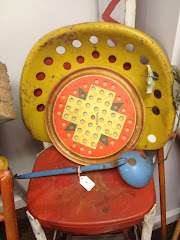 A Vintage Baby Nursery is Charming
A Vintage Baby Nursery is CharmingMany young couples today are discovering how charming vintage and retro accessories can look in their baby's nursery. Not only are these collectibles colorful and attractive, but they are often one of a kind and reasonably priced alternatives to expensively made objects.
Hunting for Baby and Nursery Collectibles
There are many collectibles which can be found that are suitable for a charming baby nursery. Here are some ideas of older items that work well in a baby room. Hand painted hangars, painted cottage furniture, old prints, altered art, plastic nursery diaper container sets, ceramic planters, old calendars, vintage records, old dolls, birthday car
 ds, paper dolls, advertising tins, toys, quilts, pillows, framed puzzles, blocks, doll furniture, dog and cat rel
ds, paper dolls, advertising tins, toys, quilts, pillows, framed puzzles, blocks, doll furniture, dog and cat rel ated prints and novelty objects, books, wall decor, child size chairs and rockers, bassinetes, tables, and more.
ated prints and novelty objects, books, wall decor, child size chairs and rockers, bassinetes, tables, and more.Choosing a Theme for Your Baby Nursery
Often it is helpful to develop a theme for your baby nursery and than to go out shopping (hunting) to find coordinated textiles, ceramics, prints etc. with that theme. For example, if you love Scottie dogs, you can begin your search with this popular doggie image in mind. The 1940's was an era with lots of Scottie dog accessories. For more ideas about dog collectibles, be sure to read "Flea Market Fido's" by Barri Leiner and Marie Moss.
Other themes could be nursery rhymes, children's book characters, plaids, polka dots, stripes, teddy bears, rabbits, jungle animals, cats, Western (cowboys and cowgirls) etc.

Flea Market Baby
You will see plenty of baby nursery themes illustrated in "Flea Market Baby" also by Leiner and Moss. This is one of my favorite books. While it has been out for awhile, it is still available and a wonderful reference. You will also find ideas and photos in my two books "Hot Cottage Collectibles for Vintage Style Homes" and "Hot Kitchen and Home Collectibles of the 30s, 40s, 50s".
Photos courtesy of http://cottageatleesburg.com/shop/ and http://www.pinkpigwestport.com/
C. Dianne Zweig is the author of Hot Kitchen & Home Collectibles of the 30s, 40s, 50s and Hot Cottage Collectibles for Vintage Style Homes. She is also the Editor of Iantiqueonline.com an actively growing internet based resource community for people who buy, sell or collect antiques, collectibles and art. You can find Dianne’s fabulous retro and vintage kitchen, home and cottage collectibles at The Collinsville Antiques Company of New Hartford, CT, a 22,000 feet antique emporium with an in-house retro café.
To read more articles by C. Dianne Zweig click on this link:
C. Dianne Zweig’s Blog Kitsch ‘n Stuff
Email me at dianne@cdiannezweig.com
Visit my website, CDianneZweig.com
Dianne is a member of:
The American Society of Journalists and Authors
The Authors Guild, Inc.







































